"Purr-fect Pet Parenting: Tips, Advice"
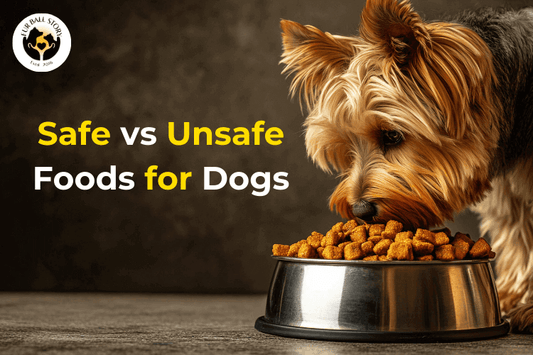
Dog Food: What to Feed and What to Avoid?
Stuck between what to feed and what to avoid feeding to your pet? With so many food items that you think are harmless can actually be poisonous to your pooch. Our expert...
Dog Food: What to Feed and What to Avoid?
Stuck between what to feed and what to avoid feeding to your pet? With so many food items that you think are harmless can actually be poisonous to your pooch. Our expert veterinarians are here to guide you through such challenges. Check this blog on Dog Food: What’s Safe and What’s Not? and know about the food items that can be harmful to your dog along with their safe, nutritious alternatives. What Not to Feed to Your Dog? Grapes & Raisins - Grapes have tartaric acid that damages the kidneys of dogs Onion - Contains n-propyl disulfide which causes anaemia (reduces HB of your dog) Garlic - Contains thiosulfate which causes anaemia, gastrointestinal issues such as vomiting and diarrhoea Chocolate - It contains theobromine which primarily affects the central nervous system, cardiovascular, and respiratory system Caffeine - It can cause heart issues, nervous signs like seizures, tremors and gastric issues Alcohol- The toxicity of alcohol can cause severe central nervous system depression, coma, and acidosis in dogs. Sugar-Free Candy & Gums -They contain xylitol, even small amounts of xylitol can cause hypoglycemia or low blood sugar, seizures, liver failure, or even death in dogs. Avocados - They contain persin which is toxic to dogs and can cause vomiting, diarrhea, and gastrointestinal upset. Macadamia Nuts - These nuts are toxic to dogs and cause weakness, lethargy, lack of muscle control, tremors, and fever. Raw Eggs - Eggs have an antinutritional factor known as avidin which prevents the binding of biotin and vitamin B in the body, which gets inactivated by boiling. Raw eggs have the chance of transferring salmonella to your dog. Raw or Undercooked Meat- Feeding these can lead to many kinds of bacterial infestation along with tapeworm infection. Food Cooked with Spices - Their feeding can cause digestive issues, gastric ulcers, and excessive thirst. Undiluted Milk - most dogs have mild lactose intolerance, so giving them milk in large quantities and undiluted can cause digestive issues. Bakery Products - bakery products generally have very large amounts of sugars, refined wheat flour, sometimes chocolate, caffeine and many other ingredients that do not contain any kind of nutritional factor and some have toxic compounds in them. Human Cerelac - it contains large amounts of sugars which are not apt for pups, hence they should always be given dog cerelac. Fried Food - It can lead to gastric issues, pancreatic problems, heart diseases Ice Cream - feeding this can cause dental issues, gastric problems, weight gain Bones - Giving big bones can lead to choking problems in dogs, sharp bones can damage the mouth, throat, stomach, and intestines. Unripened Tomatoes - They contain large amounts of tomatine, solanine can cause tremors, gastric upset and affects the heart. Citrus fruits: Contain citric acid, which can cause an upset stomach or problems with the dog's central nervous system What You Can Feed to Your Pet? Full-Boiled Eggs - Boiling the eggs activates anti-nutritional factors. It is generally recommended to give 1 egg per 10 kg of your pet's body weight. Boiled Pumpkins - It is enriched with high fiber, prebiotics, vitamins A, C, E and minerals like iron and potassium. Thus, feeding pumpkins is a healthy choice. Boiled Potatoes, Sweet Potatoes - When combined with other ingredients like curd or rice in small amounts, boiled potato is good for pets. Carrots & Cucumbers - Enriched with fiber content and vitamin A, carrots and cucumbers are healthy for dogs who need weight loss. Bananas, Seedless Apples & Watermelon - They can be given in small quantities. Chapatis without Ghee - The dogs who are not allergic to wheat (gluten), chapatis can be fed. Boiled Lentils without Spices- Lentils are a rich source of protein, fibre and many other nutrients. It can be given without adding any spices Curd (At room temperature) - Curd is a good source of probiotics. Make sure you are feeding it at room temperature, not straight out of the refrigerator Cooked Meal - Chicken and mutton can be given only after cooking the flesh properly. White Rice - It is considered healthy for digestive issues as rice is easy to digest and can be used as filler to increase the volume of your dog's diet. In conclusion, by knowing what foods to offer and which to avoid, you can help prevent health issues for your furry friend. With a little care and attention, you prepare a nourishing diet that keeps your pet happy and healthy. Together, let’s ensure your fur ball enjoys a healthy, happy meal!
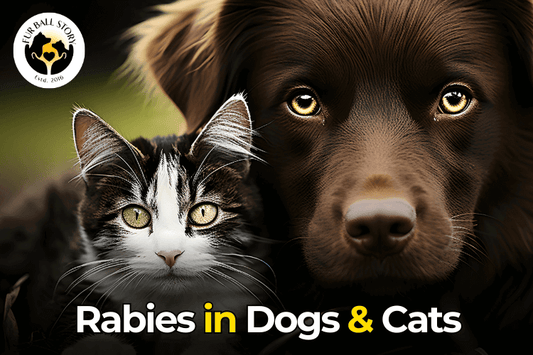
Rabies in Dogs & Cats: Here's Everything You Ne...
Rabies is a deadly viral disease that attacks the central nervous system, which includes the brain and spinal cord. It is a zoonotic disease, which is transmitted from animals to...
Rabies in Dogs & Cats: Here's Everything You Ne...
Rabies is a deadly viral disease that attacks the central nervous system, which includes the brain and spinal cord. It is a zoonotic disease, which is transmitted from animals to humans. It spreads through the saliva of infected animals via bites or scratches. It can also be transmitted if an infected animal's saliva or mucus enters the body of a non-infected person through broken skin, eyes, mouth, or open wounds. The signs of rabies appear approximately after 3 weeks to 3 months, known as the incubation period. Rabies Symptoms in Dogs Some of the common signs of rabies in dogs include: 1. Behavioural Signs Furious Form - This is the most common form of rabies in dogs, accounting for about 85% of cases. Dogs with furious rabies are aggressive, hyperactive, and may hallucinate. They may also eat or chew things like stones, mud, and litter. Eventually, fatal paralysis sets in and the dog may succumb to a violent seizure. Dumb/Paralytic Form - Dogs with paralytic rabies develop progressive paralysis in their limbs, have difficulty swallowing, excessive drooling of saliva (with or without foam) and their face becomes distorted. They often go into a coma in a life-threatening situation. 2. Nervous Signs Aggression: Dogs may show uncharacteristic aggression or attack for no reason Fear: They may show fearfulness or be afraid of water (Hydrophobia) or air blown on their face Confusion: Dogs may appear confused or disoriented Sensitivity: Rabies makes a dog sensitive to touch, sound, or light due to alterations in the nervous system Biting at the Site: Dogs may bite/scratch at the site where they were exposed to the virus Barking Differently: There can be unusual vocalization like growling, whining or barking (when not typical) 3. Lethargy and Loss of Appetite Dogs with rabies may appear lethargic or fatigued and may spend more time sleeping. The dog starts losing interest in eating and there is a huge loss of appetite. Fever can be observed in most of the cases that discourages appetite. What to do if your dog gets bitten by another animal? Rabies is one of the deadliest diseases around the world which has no cure. Once the nervous signs start to appear, it becomes life-threatening for the individual. However, the prevention of Rabies is quite easy with vaccination. So here’s what you can do if your dog gets bitten by any other animal: Immediately wash the area of the bite thoroughly with soap and water Apply an antiseptic ointment over it Immediately contact your veterinarian for the post-bite injection schedule Strictly follow the vaccination schedule and don't leave the treatment in between Common Facts About Rabies Not every dog is infected with rabies, so having a mindset that every stray dog has rabies is wrong. However, one must be cautious when around strays. Besides dogs, there are several other animals like cats, monkeys, foxes, bats, raccoons and some wild animals that can spread rabies virus. Rabies is a highly dangerous and life-threatening virus. It has no cure and it can only be prevented. Dogs need one shot of the Anti-Rabies Vaccine every year, irrespective of whether it has been bitten by another animal or not. Know More About Rabies Transmission of Rabies Rabies does not spread through the air. So if you are standing close to an infected animal, you won't catch it. Rabies does not spread through blood, urine, or faeces. The only source of spread is through the saliva of infected animals After Care for Rabies After getting bitten or scratched by any animal, strictly follow the vaccination protocol as recommended by your veterinarian. Missing any dose in between or not completing the course of treatment is highly fatal. If your pet gets bitten, get the first shot of vaccination within 24 hours of the bite to stop the spread of the virus throughout their body. Even if your dog has been already vaccinated for rabies, still you must follow the vaccine schedule after being bitten by another animal. How to Prevent Rabies? Vaccinate your pet: Keep your pet up to date on their vaccination schedule Control your pets: Don't let your pets roam and socialize unsupervised Avoid other animals: Keep distance from wild and stray animals, even if they seem friendly Know the Signs: Be aware of the risk of rabies and know about its signs to timely address the issue

Treat Dog Stomach Problems With Top 5 Herbs
If your furry friend is facing any stomach issues such as indigestion, vomiting, bloating or irregular bowel movements, it can be a major cause of discomfort and uneasiness. To soothe...
Treat Dog Stomach Problems With Top 5 Herbs
Mother nature has always healed our furry friends. Even during the absence of modern science, animals used to relieve the health issues they faced with the help of herbs around them. This natural instinct is nothing but the traditional system of Indian medicine called Ayurveda. If your furry friend is facing any stomach issues such as indigestion, vomiting, bloating or irregular bowel movements, it can be a major cause of discomfort and uneasiness. To soothe these issues, there are numerous herbs that are found commonly in Indian households. Check out this blog to learn about the Treat Dog Stomach Problems With Top 5 Herbs that provide beneficial effects on the digestive health of dogs. 1. Guduchi (Moonseed) Guduchi or Heart-leaved Moonseed is a powerful herb that boosts immunity and improves digestive health. It is anti-inflammatory and antioxidant in nature which helps to reduce inflammation in the digestive tract and enhance overall gut health. This herb also contains liver supporting properties, which makes it suitable for dogs that face digestive discomfort due to problems in the liver. 2. Elaichi (Green Cardamom) One of the most commonly found spices in every household is elaichi, but did you know it can be used to relieve digestive discomfort too? This herb supports your dog’s digestive system, and reduces bloating, indigestion, and flatulence. Enriched with natural carminative properties, it helps to soothe a gassy stomach and reduce discomfort. Using this herb also stimulates appetite and digestion, which is essential for dogs having an upset stomach. 3. Vidanga (False Black Pepper) Vidanga, also known as False Black Pepper, helps to reduce flatulence and bloating, treat intestinal worms, and improve overall digestive health. It also has mild antibacterial properties that eliminate harmful bacteria from the body. This herb relieves various gastrointestinal issues, enhances appetite, promotes better digestion, and reduces bloating and gas by facilitating smoother digestion. Vidanga helps in breaking down food and improving nutrient absorption. 4. Kasani (Chicory) Kasani is a laxative herb that is beneficial for digestion. It supports liver function and is especially useful for dogs who suffer from digestive discomfort due to liver problems. With prebiotic properties, Kasani promotes the growth of good gut bacteria and improves digestive health in the long run. It helps to combat issues such as indigestion, bloating, and irregular bowel movements. 5. Yawanika (Fennel) Fennel is a commonly found herb in the kitchen that relieves digestive issues in humans as well as pets. It helps to combat gas, bloating, and indigestion, soothes upset stomach and improves the appetite. Fennel is rich in fibre which helps to regulate bowel movements and treat constipation or irregular bowel movement. How to give these herbs to dogs? If your dog is facing digestive issues, you can give most of the above-mentioned herbs in crushed form by making a powder and mixing it with their food in small quantities. However, to reap the maximum benefits of these herbs, Pacho Pet Syrup is the solution. It contains a blend of all these herbs in perfect quantities that are tailored specially for your fur ball. Keep this vet-approved medicine handy at your home to relieve upset stomach, vomiting, diarrhea, gassy stomach, and other indigestion issues in pets. However, always consult your veterinarian before feeding these herbs to your pet to check for allergies.
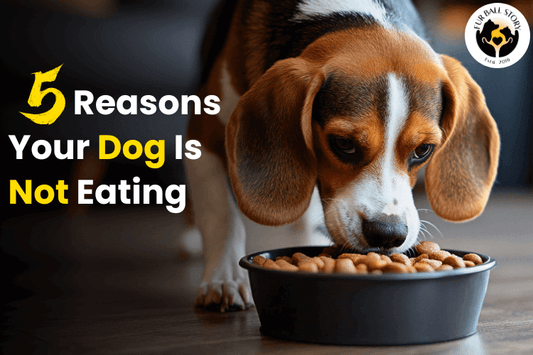
Is Your Dog Not Eating Food? Here Are 5 Reasons...
Wondering why my dog is not eating anything? Here are 5 common reasons you need to know. Check out our blog on ‘Is Your Dog Not Eating Food? Here Are...
Is Your Dog Not Eating Food? Here Are 5 Reasons...
Wondering why my dog is not eating anything? Here are 5 common reasons you need to know. Check out our blog on ‘Is Your Dog Not Eating Food? Here Are 5 Reasons Why’ to know more. 1. Health Issues Just like humans, if a dog isn’t feeling well inside, they might not feel like eating. Usually, dental problems cause discomfort while eating, due to which dogs skip meals. Health issues related to kidney, liver, gastrointestinal tract, infections, or chronic conditions can also lead to changes in appetite. Moreover, older dogs might experience age-related health issues or a decrease in their sense of smell and taste, which reduces their food intake. Check with your veterinarian to diagnose the suspected health issue. 2. Changes in Routine or Environment Dogs are sensitive to changes in their surroundings and routines. Moving to a new house, changes in feeding location, separation from loved ones, loud noise or seasonal changes might trigger stress and impact their appetite. To relieve stress in dogs, Calm Pet is one of the best natural medicines. It enhances behavior, promotes better sleep and tackles anxiety and its symptoms. Once your dog is anxiety free, it will get back to the normal feeding routine. 3. Food Preferences It's not just you craving for tasty food, your dog too gets bored with their regular meals. They might reject a new brand or flavor and skip meals if they're not satisfied with what’s being fed. Besides treats, dogs enjoy eating chicken, eggs, fish, frozen veggies and more. Just make sure that their diet contains a balanced mix of proteins, fats, carbohydrates, vitamins and minerals. Most of the regular food fails to provide these essential nutrients, especially when the dog is a picky eater. That’s why you need supplements like Cannivin. Make your dog drool over this peanut butter flavored spray while providing them all the nutrients like zinc, selenium, iodine, stevia and more. 4. Overfeeding Avoid giving too many treats to your dog. This makes them feel full due to which they end up rejecting their regular meals. The body starts adjusting to the excessive calorie intake, which impacts the hunger signals and eventually leads to a decreased appetite. This can also be accompanied by discomfort, bloating, or even nausea. Thus, prefer giving treats only as occasional rewards instead of relying on them completely. 5. Ongoing Medication There are some medicines that can cause side effects such as feeling nauseous or appetite changes. Discuss with your veterinarian before starting any medication to understand about the side effects. Moreover, it can be possible that your pet has a sensitive stomach that is allergic to the ongoing medicine. In such a case, talk to your veterinarian to get recommendations for a different treatment option. How to improve digestion in dogs? Pacho Pet is a natural digestion syrup for dogs that is enriched with Guduchi, Cardamom, Vidanga and other Ayurvedic Herbs. It relieves indigestion, balances appetite intake, and treats vomiting, diarrhea and flatulence. It works directly on dog digestive system to improve digestion and relieve any problem being faced.
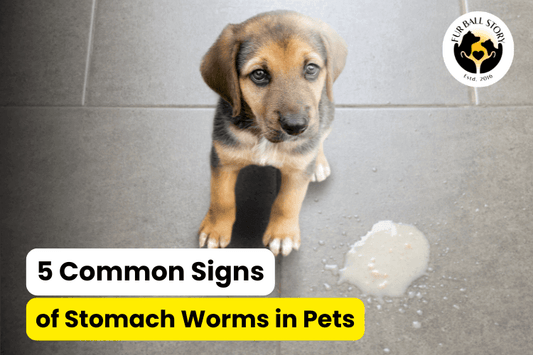
5 Common Signs of Stomach Worms in Pets
As worms greatly hamper the digestive system, they can cause issues related to the stomach, respiratory system and skin. These parasites absorb the vital nutrients from food and gradually weaken the...
5 Common Signs of Stomach Worms in Pets
As worms greatly hamper the digestive system, they can cause issues related to the stomach, respiratory system and skin. These parasites absorb the vital nutrients from food and gradually weaken the dog. This causes symptoms like indigestion, cough, dull skin and several other issues. Check out the details below: 1. Upset Stomach Dogs with stomach worms can frequently experience upset stomach. Intestinal parasites release toxins that hamper digestion and lead to indigestion. They cause blockage in the digestive tract, which makes the stomach content flow out abruptly as vomiting, diarrhoea and gases. Worms can be visible in the vomit or stool. Upset stomach can be relieved using Pacho Pet, a 100% natural digestion syrup for dogs and cats. 2. Changes in Appetite Worm infestation can affect your pet’s food intake. If you notice sudden appetite changes, there is a high possibility of stomach worms. This can cause either increased hunger or lower food intake. If your dog’s metabolic activity increases, this can be because the body has to work harder to fight the toxins released by worms, which require more nutrients. On the other hand, food intake decreases because worms soak up nutrients from the body and dog is left with low energy and less interest in food. This issue can be resolved using Supertonic, an all-natural syrup that boosts immunity and supports essential body functions. 3. Scooting Scooting means dragging or rubbing the lower body on the ground to relieve itching and discomfort around the anal region. This might be accompanied by the passing of worms in stool. Besides, keep checking for other signs of parasites through their poop examination or around their bedding. 4. Skin Issues The deficiency of nutrients can cause skin problems such as dryness, itching, and hair loss. The immune system weakens and the skin becomes more susceptible to allergies, infections, or other dermatological issues. To relieve this issue, addressing stomach worms is necessary, besides providing skin the missing nutrients. Use peanut butter-flavoured CanniVin Spray to supply essential nutrients to the skin and provide internal nourishment. 5. Respiratory Disorders Some worms have larvae that can travel through the bloodstream and reach various organs, including the lungs, causing respiratory symptoms like coughing, shortness of breath and even pneumonia. To relieve fever and respiratory issues in dogs and cats, Fev Pet is the best natural solution. It also increases platelet count and boosts immunity against recurring viral infections. How to Prevent Stomach Worms in Pets? Stomach Worms can be prevented using Worm No More, a 100% natural tablet that eliminates intestinal parasites in pets. If you witness any of the above signs, check for their deworming schedule first. When deworming, go for an all-natural option as it is safe for pets. It has minimum side effects and no health risks in the log run.
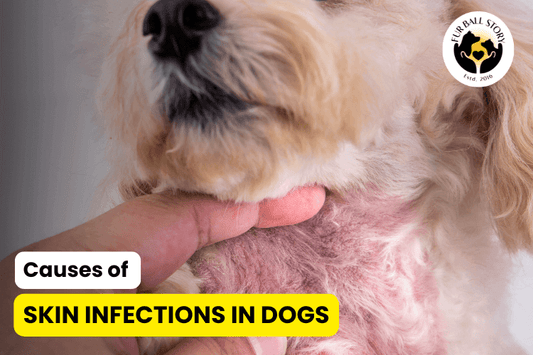
Causes of Skin Infections in Dogs
A few signs of skin infections in dogs are itching, redness, hairloss, rashes and pigmentation. If you spot any signs, here are the factors that might be responsible for the same. These include:...
Causes of Skin Infections in Dogs
A few signs of skin infections in dogs are itching, redness, hairloss, rashes and pigmentation. If you spot any signs, here are the factors that might be responsible for the same. These include: Allergic Reaction Hormonal Imbalance Nutritional Deficiency Poor grooming 1. Allergic Reaction Some dogs can be allergic to food, environmental agents like pollen grains, dust, or skincare products. Other allergens can also be humidity, poor hygiene, or exposure to irritants that contribute to skin infections. These allergies can lead to secondary infections if left untreated. The best treatment option is to identify the source of the allergy and keep your pet away from it. However, relief from allergies can be provided by using Eczo Pet. It helps to treat rashes, redness, pigmentation, hives, and infections. Eczo Pet is a natural medicine that relieves skin infections and allergic reactions. This cream is free of harmful chemicals and remains gentle on the skin. 2. Hormonal Imbalance Underlying conditions like hypothyroidism or Cushing's disease can cause hormonal imbalances, increasing the risk of skin infections. Autoimmune diseases can also cause lesions and infections as the body's immunity starts attacking its own skin cells. Supertonic is a natural health supplement that can be given daily to boost immunity along with other body functions. Not only skin, this syrup ensures the overall wellness of pets including kidneys, liver, brain, etc. 3. Nutritional Deficiency A diet lacking essential nutrients can weaken the immunity and skin, making it prone to infections. The deficiency of omega 3, copper, vitamin A, biotins and vitamin B7 can cause such infections. A regular diet might not be able to provide all the necessary nutrients to the skin. It is advisable to supplement their regular meal with add-ons to nourish their skin internally. CanniVin Spray for Healthy Skin and Shiny Coat is India's most potent supplement that provides essential nutrients to the skin. Simply spray CanniVin in your pet's mouth and see visible results within a month. It prevents hair loss, dandruff, breakouts, pigmentation, itching and dryness. 4. Lack of Grooming Lack of brushing and cleaning allows the dirt, dead hair and moisture to trap on the outer layer of skin. This leads to the overgrowth of bacteria, fungi, and parasites that further cause skin infections. Regular grooming also allows you to spot the signs of skin issues at early stages. Shampooch is a natural dog shampoo for healthy skin and shiny coat that is suitable for regular grooming. It helps to nourish the skin while removing all the impurities. Moreover, it reduces foul odors, prevents hairfall & dandruff, eliminates dryness and flakiness and improves the texture of the skin. Treatment of Dog Skin Infection To relieve skin infections in pets, use Eczo Pet. It is a natural medicine that helps to treat skin infections such as Eczema, Dermatitis, Mange, hives, ringworms and more. This cream helps to control fungal infections and common skin issues, soothes irritated skin and prevents bacterial buildup.
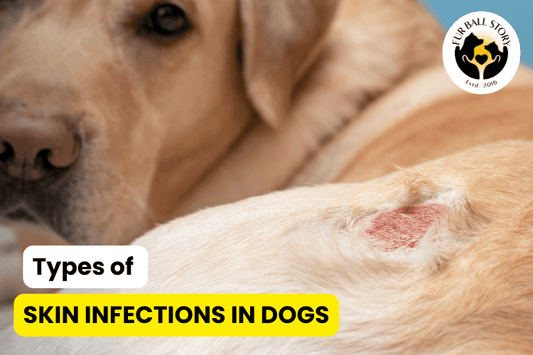
Types of Skin Infections in Dogs
When it comes to our furry friends, their health and well-being are of utmost importance. An issue that pet parents may commonly face is skin infections. To know the types of...
Types of Skin Infections in Dogs
When it comes to our furry friends, their health and well-being are of utmost importance. An issue that pet parents may commonly face is skin infections. To know the types of skin infections in dogs 1. Bacterial Infection Bacterial infections can be caused due to allergies, hormonal imbalance, low immunity, or lack of regular grooming & cleanliness. The symptoms of bacterial infections in dogs include pustules, redness, itching, crusts, sores, hair loss or odor in a specific area. Bacteria can also enter the body through cuts and wounds, leading to skin infections. By taking care of wounds using Heal Pet, such infections can be prevented. This medicine offers rapid pain relief and helps in faster healing of the skin. Every pet parent must keep this wound medicine for dogs and cats handy at home. Moreover, to prevent these bacterial infections, keep your dog's skin clean and dry and practice grooming routine. 2. Fungal Infection Fungal infections can be seen as circular patches of hair loss, itching, redness, inflammation, scaling, pigmentation, or skin odor. Fungus is often found in areas like the ears, paws, and folds of skin. It is necessary to remove dead hair and skin cells that trigger fungal infections. To prevent this, practice regular grooming, brushing, cleaning of toys, living space and bedding. Avoid going to wet areas as yeast grows in moist environments. Keep your dog dried after baths and feed them a well-balanced diet to build their immunity against such infections. Remember, fungal infections can spread from other dogs too. So, restrict the exposure when outside. Immediately use Eczo Pet if you see any signs of skin infections, to prevent further damage. 3. Parasitic Infections Fleas, ticks, mites and lice can cause skin infections which often lead to hair loss, itching, and inflammation. They are one of the major causes of itching, irritation, redness, and hair loss. Parasites attach to the skin and feed on the blood, which can further transmit diseases. Changes in grooming practices along with environmental controls can help to eliminate parasites. Moreover, use Tick Free Spray to keep away ticks and fleas from your pet. This natural medicine helps in the easy removal and prevention of ticks. Simply spray on tick-prone areas before walks whereas for tick removal, use the spray on the tick and comb using a tick comb within 2-3 minutes. 4. Yeast Infections Yeast is found in warm and moist areas such as between paws and ears and is usually harmless. However, the overgrowth of yeast can be harmful and cause skin infections. Yeast overgrowth in dogs can cause itching, redness, smelly discharge, scratching of ears, flakiness and other symptoms. To prevent yeast infections, regularly clean bedding and maintain good hygiene and grooming practices. For regular cleansing of the skin, use Shampooch. It is a herbal dog shampoo that is enriched with natural ingredients like Aloe Vera, Clove Oil and Lemongrass Oil. This shampoo for dogs helps to remove impurities, eliminate foul odor and prevent hairfall & dandruff. How to treat Skin Infections in dogs? Since the skin is already sensitive, using chemical based products can worsen the situation. Prefer using Eczo Pet as it comprises 100% natural ingredients such as Somwalka, Neem and Bakuchi. It relieves common dog skin issues like mange, dermatitis, eczema and various allergies while ensuring faster recovery from the infection.
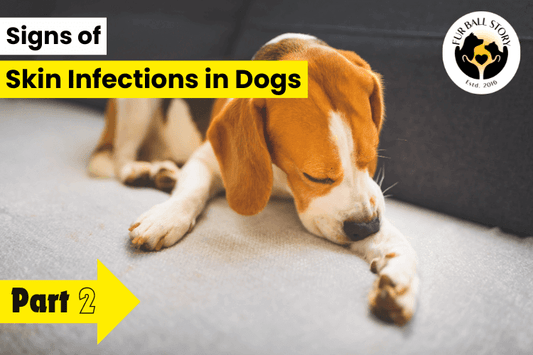
Signs of Skin Infections in Dogs: Part 2
From excessive itching to visible redness, signs and causes of skin infections can be diverse. In Part 2 of our series, let’s understand more signs of skin infections in dogs....
Signs of Skin Infections in Dogs: Part 2
From excessive itching to visible redness, signs and causes of skin infections can be diverse. In Part 2 of our series, let’s understand more signs of skin infections in dogs. Check out the blog on ‘Signs of Skin Infections in Dogs Part 2’ and learn about these indicators to ensure that your pet receives timely care. 1. Redness or Inflammation To heal the infected skin, the immune system sends white blood cells and other relieving agents to the site of infection. This helps to fight off bacteria but the process leads to swelling and redness. Moreover, inflammation of blood vessels causes extra blood to flow in the infected area and transfer immune cells for repairing the skin. This increased blood flow appears on the surface as redness. To relieve the condition, Eczo Pet is one of the best medicines for skin infections in dogs and cats. It contains 100% natural ingredients that ensure no side effects on the sensitive skin of your pet. 2. Recurrent Skin Infections Underlying health issues such as Diabetes, Hyperthyroidism, Hyperadrenocorticism, liver or Autoimmune diseases can be responsible for hormonal imbalances that cause recurring skin infections. Besides, dogs with environmental, food or other allergies can also experience recurring skin infection and irritation. Seek veterinary advice for personalized care. 3. Hyperpigmentation/ Hyperkeratinization These are chronic skin conditions that occur during a skin infection. Hyperpigmentation is characterized by an increase in melanin production that causes darker skin or hair. Conditions such as cushing's disease, hypothyroidism, or skin allergies can be responsible for hyperpigmentation, which can be treated by addressing the underlying cause and reducing inflammation. On the other hand, hyperkeratinization is caused by overproduction of keratin, leading to thickened skin. It can be caused by conditions such as seborrhea, eczema or zinc deficiency. Reducing keratin production, moisturizing and addressing the underlying cause can help relieve the issue. 4. Foul Odor Some of the factors responsible for foul odor in pets are bacterial growth, yeast infection, metabolic disorders or systemic infections. Also, poor maintenance of hygiene can be the reason that your dog emits a bad smell. To prevent this condition, brush your dog regularly to get rid of dirt and loose hair. Clean their ears regularly using Clear Ear and feed a nutritious diet to maintain healthy skin and coat. For regular grooming, use Shampooch, which is a herbal dog shampoo to prevent foul odor, hairloss and other skin problems in dogs. 5. Changes in Appetite Skin infections can cause your pet to feel irritated and uncomfortable, due to which they don’t feel like eating. The skin issues which are symptoms of underlying diseases such as hypothyroidism, Cushing's disease or autoimmune diseases show changes in appetite as additional symptoms. Imbalanced diet and nutritional deficiencies can also contribute to skin problems, which further lead to changes in appetite. 6. Skin Lesions The spotting of pimples, acne, eczema or rashes on the skin is nothing but skin lesions. It can be caused due to clogged hair follicles, hormonal changes, irritants or allergies, fungal and bacterial infections. The immune response to infection also leads to inflammation in the affected area besides causing redness, swelling, and warmth of the area. Moreover, if any cuts or wounds become infected, it can lead to lesions, while excessive scratching or biting can spread the infection. Heal Pet is one of the best medicines to treat wounds. It helps in rapid healing of the area with natural ingredients such as Jati, Mulethi, Neem, Jatyadi Oil, Camphor and Tulsi. 7. Sensitive or Painful to Touch Through pain or sensitivity, the body signals that something is wrong. Inflammation of the infected area makes the nerve endings more sensitive to transmit pain signals to the brain; so touching the area causes immense pain. Also, the infected area becomes inflamed due to the accumulation of fluid, which exerts pressure on surrounding tissues and nerves and causes pain and sensitivity. Also Check out: Signs of Skin Infections in Dogs: Part 1 How do you treat a skin infection in a dog? Eczo Pet is a vet-approved medicine to relieve skin infections in dogs and cats. It addresses fungal, bacterial and yeast infections while treating Eczema, Dermatitis, Mange and other skin issues. This medicine is free of harmful chemicals and contains 100% natural ingredients such as Somavalka, Bakuchi and Neem. It remains gentle on the skin while relieving irritation and itching on the site.
